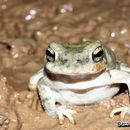Description
provided by AmphibiaWeb articles
No cranial crest; interorbital space slightly concave, a little broader than upper eyelid. Tympanum very distinct. First finger longer than second. Subarticular tubercles of toes single, no tarsal fold. Parotoids depressed, elongated to sacral region. Tarsometatarsal articulation reaching in front of eye. Dorsum smooth.Color: Uniform gray dorsum, with darkish spottings on limbs, ventrum whitish.For references in the text, see here
Eiselt, V.J. and Schmidtler, J.F. (1973). ''Froschlurche aus dem Iran unter Berucksichtigung ausseriranischer Populations-gruppen.'' Annals Naturhistorische Museum Wien, 77, 181-243.
Distribution and Habitat
provided by AmphibiaWeb articles
Bufo olivaceous is recorded from the extreme western parts of Balochistan and adjoining Iran. Minton (1966) found little difference between B. olivaceous and B. stomaticus, while Eiselt and Schmidtler (1973) are inclined to conside it as a subspecies of Bufo stomaticus.
Life History, Abundance, Activity, and Special Behaviors
provided by AmphibiaWeb articles
Tadpole: Typically bufonid, with oval, bulging body and weak tail. It inhabits ponds and puddles in oasis and date palm groves in Dalbandin and Kharan, southwestern Balochistan. Body is light brown, with dark specks on tail and fins, ventrum darkish white. The oral disc is typically bufonid, labial tooth row formula 2(2)/3, oral papillae are lateral. The tadpole feeds on algal vegetation and other concretions deposited on the surface of submerged objects. Total length 24-26, tail 20-22 mm.
Life History, Abundance, Activity, and Special Behaviors
provided by AmphibiaWeb articles
Prolonged droughts, chemical pollution, pesticides.
Relation to Humans
provided by AmphibiaWeb articles
Depends on wetlands created by agricultural activity, around salt lakes. It extends in human inhabitations, feeding on light attracted insects.

